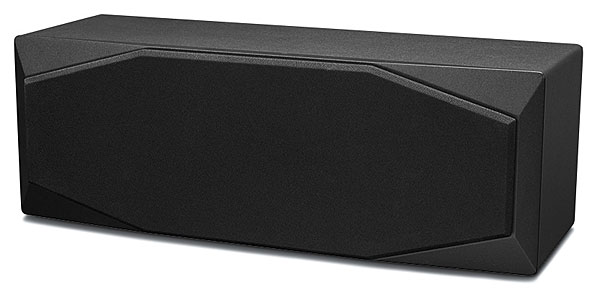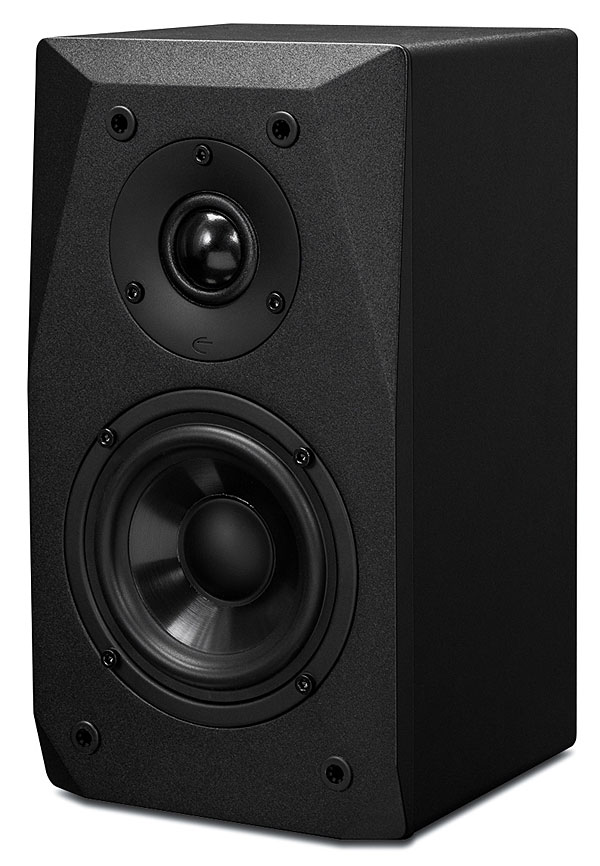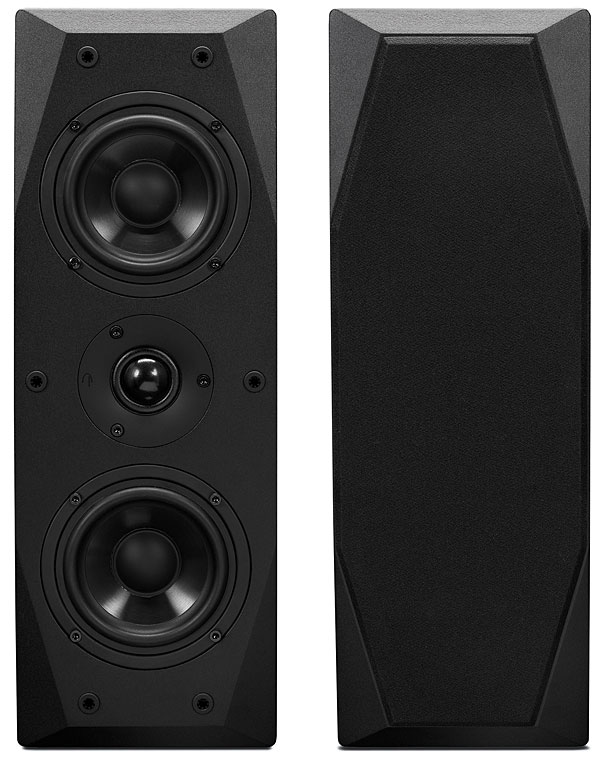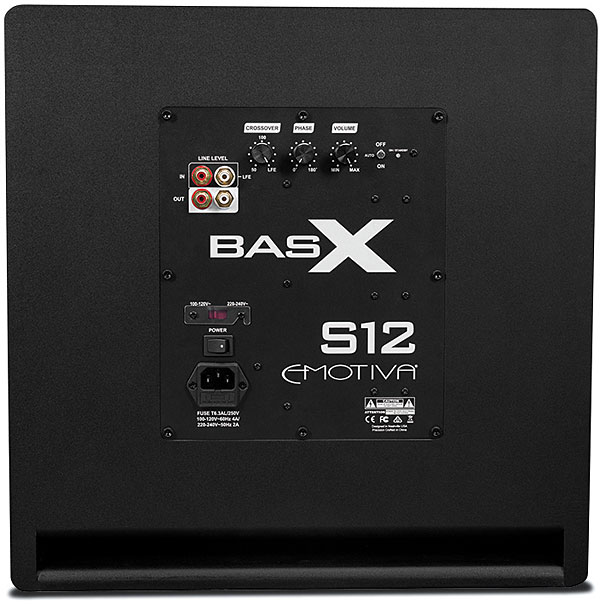Emotiva BasX System Review Page 2
I conducted three separate sets of demos to formally evaluate the electronics and speakers independently and then the full Emotiva system: (1) the BasX pre/pro and amp with my Paradigm Reference Studio 20 v.4 speakers; (2) the BasX speakers with my Denon AVR-X7200W receiver; and finally (3) the Emotiva pre/pro, amp, and speakers together—the essential subject of our system review. Signal sources included a Panasonic DMP-BD87 player for Blu-ray and streaming, Micro Seiki BL-51 turntable, Shure M97xE cartridge, and Denon PRA-S10 serving as phono preamp.

MC-700 and A-500 Listening
For phase one, I first connected the pre/pro and amp to my Paradigm Reference Studio 20 v.4 speakers and Seismic 110 sub. This gave me a sense of how the electronics would sound with familiar speakers, which happen to measure reasonably flat. My first impression was an inoffensive crispness, which after brief break-in evolved into a sound that was reliably clear and clean. While there was no additive warmth to sweeten the tonal balance, the pre/pro and amp still achieved a high degree of listening comfort, probably because the amp was powerful enough to avoid major clipping in my midsized room at the moderately high volumes I find comfortable for action movies. It also had enough low-level resolution to make dialogue audible and casual background listening a pleasure. Whether you want excitement or relaxation, Emotiva’s got you covered.
The Great Wall (Dolby Atmos/TrueHD 5.1 core) plunges Matt Damon into a medieval Chinese action fable bristling with animated scary monsters and busy surround effects. I fooled around with modes: Emo-Q, with room EQ; flat, which leaves postprocessing but sets EQ to zero; and direct, which digitally bypasses EQ and post-processing. Emotiva’s room EQ in my space followed the critical “do no harm” rule: It didn’t skew frequency response into uncomfortably bright territory, though it did throw imaging into higher relief. I could hear its sculpted images diminish when I turned it off. Even without room EQ, this pre/pro and amp sounded great together, providing a best-case depiction of what I like about my room’s uncorrected midrange character. With Emo-Q massaging the bass, and with the amp operating above the 80-Hz crossover I use for the Paradigms, the system confidently carried the thunder of hooves, pounding of war drums, and explosions of Chinese-invented gunpowder, all of it with abundant but well-measured weight. Dialogue was admirably clear, even at low volumes.

Stepping down from epic to B-movie, The Bye Bye Man (DTS-HD Master Audio) signals horror with a repeated music-and-effects crescendo that ends in dead silence, giving the amp a chance to fill all channels with noise, then make the drivers stop on a dime. The amp’s control was admirable. It also adeptly handled more violent effects, such as a rifle blam.
“Blackwater” (Dolby Atmos/TrueHD 5.1 core) is better known as season 2, episode 9 of Game of Thrones. It includes the famous scene of green “wildfire” thunderously devouring a harbor full of warships and burning screaming men alive. The amp had no trouble filling all five channels with these steroidal effects—but it also got maximum detail out of war drums, hand-to-hand combat in the siege of King’s Landing, and (in the opening scene) the atmospheric creaking and water-whoosh of a soon-to-be-doomed ship at sea.
While Netflix bingeing wasn’t an official part of the demos, the pre/pro and amp did see me through the third season of Narcos (with Pedro Pascal as the DEA agent; he also appeared in The Great Wall) and random samples of the first eight seasons of Anthony Bourdain: Parts Unknown. I came to love how they caressed the Latin-flavored theme of the former and blasted the crunching alt-rock theme of the latter. I didn’t mind hearing them over and over.
My classical selection for this test was Sviatoslav Richter in Rachmaninoff’s Piano Concerto No. 2, with Stanislaw Wislocki conducting the Warsaw Philharmonic Orchestra in 1959, and Tchaikovsky’s Piano Concerto No. 1, with Herbert von Karajan conducting the Vienna Symphony in 1962. I haven’t got $429.35 for the Japanese SACD on Amazon, so I settled for Deutsche Grammophon’s 1996 CD. DG’s engineers weren’t on their home ground when they taped the Rachmaninoff in Poland, and I was curious to hear how the pre/pro and amp would cope with the recording’s pronounced treble. Clean amplification aced the test, beautifully defining the sharp edges without letting them lacerate my ears with coarse noise. When I moved on to the Tchaikovsky—brilliantly recorded around the same time as Karajan’s definitive Beethoven symphony set—the results were even better, with more soundstage depth. In both works, the amp collaborated intimately with the pianist, keeping up with his world-class dynamic prowess and rhythmic incisiveness. It was exhilarating.

From the concert halls of Warsaw and Vienna, I moved on to a true Trenchtown sensation: Catch a Fire by Bob Marley and the Wailers (CD), with the once provocative cover pic of Marley doing something now legal in 29 states and the District of Columbia. The big question was how Emo-Q, the Paradigm sub, and the amp would handle the bass of Aston “Family Man” Barrett. The answer: with clean and distinct pitches. Emo-Q neatly tailored the bass to my room, observing the distinction between a clear, deep note and a messy, unfocused one.
Next up was Desmond Blue: Paul Desmond with Strings, a showcase for Dave Brubeck’s alto sax man with orchestral arrangements by Bob Prince, on a well-preserved RCA Living Stereo LP from the 1960s. The pre/pro and amp lofted the sax above the orchestra as if it were a corporeal being. The recording made the strings sound canned but was kinder to the woodwinds, allowing them (along with the sax) more spatial realism and tone color, which Emotiva’s electronics imaged credibly. The system showed that it was as good with Milt Hinton’s string bass as it was with Family Man’s electric bass, conveying believable timbre and subtle dynamic shading.
BasX Speaker Listening
Phase two involved a complete change to the Emotiva BasX speakers and sub mated with my reference Denon AVR-X7200W receiver, that brand’s current top-line model, which retails for $2,999. I’ve used this receiver to review many other speakers at all price levels, and it’s measurably more powerful than the Emotiva amp. The idea, of course, was to evaluate the speakers with familiar amplification, albeit a receiver rather than separates, and without the Denon’s Audyssey room correction engaged, because that would violate normal review practice and impose one variable too many. If anything, I was relieved to go back to Denon’s speedier and better-looking user interface.
BASX Speakers AT A GLANCE
Plus
Silk domes and polypropylene cones
Contours minimize diffraction
Beefy sub with 300-watt RMS amp
Minus
Soft voicing sacrifices some dialogue clarity and musical detail
As I balanced the channels with a meter, the first thing I noticed was that test signals sounded nearly identical between the LCR and Sat; they were closely timbre-matched. With their detailed upfront midrange, the BasX speakers, driven by the Denon, had a warm and relaxed voicing. That suggested they would make excellent mates for the separates. Compared with the Paradigms, they eventually proved to be a step down in resolution, soundfield dimensionality, and image focus, whether running with the Denon or the BasX electronics—no surprise or fault there, given that they are a fraction of the Paradigms’ size and cost. As for the BasX S12 sub, it also delivered less definition than my Paradigm Seismic 110 but offered loads of reasonably clean output, keeping up surprisingly well with the Paradigm—at a fraction of the price. The difference was immediately apparent with some of my unintended streaming test material: The opening theme of the Bourdain show warmed up compared with the sound on the Paradigms via the BasX electronics, and the vivid texture of the grunge guitars got soft-focused.

Did the first impression hold steady in the movie demos? In The Great Wall, once I got used to the different tonal balance, I couldn’t identify any specific details in the Emotiva/Paradigm demo that were missing from the Denon/Emotiva demo. I did work the master volume keys occasionally to reconcile soft dialogue and loud effects—not because the BasX speakers were shrill with effects, but because their dialogue reproduction wasn’t as clear as I’m used to. On the other hand, the soft focus allowed the system to play relatively loud and degrade gracefully (as opposed to gratingly) when stressed—no “ouch” moments. On the bottom end, the S12 sub continued to impress. It handled the movie’s war drums and battle effects as self-assuredly as an experienced butcher swinging a cleaver at a ham hock. Bass extension was excellent, and dynamics (as my notebook reminded me) were “awesome.”
The Bye Bye Man, whose effects were less demanding, came through about as well with the BasX speakers as with the Paradigms. However, the former’s softer voicing called my attention more to the low-frequency effects this time around, from the ominous low tones embedded in the music to the violence of the train and car crashes. The overall balance was noticeable enough to prompt a rethink of the sub crossover, which up to this point had seemed well dialed in. The LCR speakers are rated –3 dB at 80 Hz; to avoid a notch, I had set the crossover in the receiver for 100 Hz. I ran the test tone again with meter in hand, though acknowledging that when prepping a sub, the ear ranks over the meter. Net result: My ear ruled that the setting was not out of bounds, the meter agreed, and I could enjoy the S12’s full-sounding bass with a clean conscience.





























































